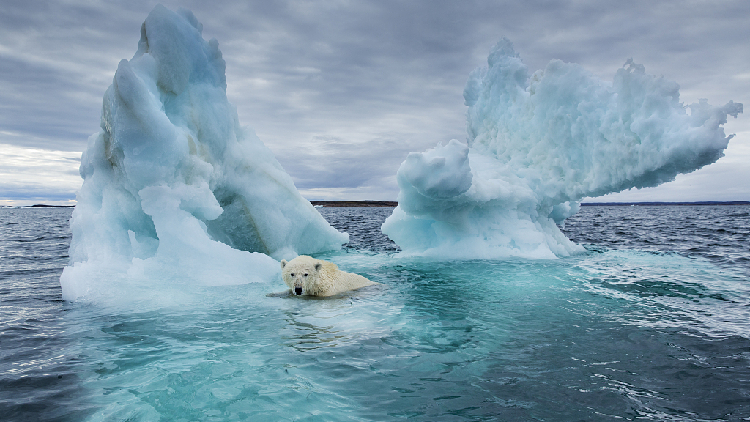Much Arctic Sea Ice Youre Melting Every Ton Carbon Dioxide Emit

The Arctic region, synonymous with pristine landscapes and diverse ecosystems, is undergoing a profound transformation, primarily attributed to the relentless emission of carbon dioxide. As industrial activities continue to surge globally, the resulting greenhouse gas releases are not only warming the planet but are having a dire impact on the Arctic sea ice. This ice, which plays a crucial role in regulating climate patterns and marine life, is diminishing at an alarming rate. Understanding how much Arctic sea ice is melting for every ton of carbon dioxide emitted is paramount for comprehending the nexus between human activity and climate change.
To appreciate the significance of this issue, we first need to recognize the role of Arctic sea ice in the Earth’s climate system. Sea ice regulates global temperatures by reflecting sunlight back into space, a phenomenon known as the albedo effect. Beneath its surface lies a complex ecosystem that supports myriad species, from polar bears to krill. The loss of sea ice could lead to significant ecological repercussions, disrupting food chains and potentially leading to the extinction of certain species.
Recent scientific studies have employed cutting-edge climate models to ascertain the correlation between greenhouse gas emissions and Arctic sea ice extent. The findings are alarming: for every ton of carbon dioxide that enters the atmosphere, a significant fraction results in a loss of sea ice. Research indicates that this relationship is not linear; rather, it demonstrates a compounding effect, exacerbating the rate at which ice melts as temperatures rise.
One pivotal study outlines that the Arctic has warmed approximately three times faster than the global average. This accelerated warming can be attributed to various feedback mechanisms triggered by climate change. For instance, as the Arctic warms, more sea ice melts, exposing darker ocean water that absorbs more sunlight, which in turn accelerates further ice loss. This cycle creates a feedback loop that intensifies the warming trend, leading to a dramatic reduction in sea ice coverage.
Quantifying the impact is complex, but estimates suggest that every ton of carbon dioxide emitted leads to the loss of roughly 1.5 square meters of Arctic sea ice. While this figure may seem minimal in isolation, it accumulates significantly when viewed within the context of global emissions, which total billions of tons annually. The cumulative loss of sea ice not only alters the Arctic landscape but also has profound implications for global weather patterns, sea levels, and ecosystems worldwide.
Furthermore, the interconnections between Arctic sea ice and the broader climate system cannot be understated. The melting of sea ice contributes to rising sea levels, as the global ocean absorbs more heat, causing thermal expansion. This rising sea level poses a significant threat to coastal communities and ecosystems. Moreover, the reduction in reflective ice may disrupt atmospheric circulation patterns, leading to extreme weather events far beyond the Arctic region. Changes in jet streams, for instance, have been linked to more severe winters in some areas and anomalous heat waves in others.
From an environmental perspective, the melting ice also releases trapped greenhouse gases from organic matter on the seafloor, further exacerbating climate change. As permafrost thaws, it releases methane—a potent greenhouse gas—which can accelerate the warming trend in a perilous cycle. The implications are staggering: as Arctic temperatures rise, the potential for releasing additional greenhouse gases increases, leading to further temperature rises and ice loss.
International efforts to mitigate climate change often focus on reducing carbon emissions. Achieving a sustainable balance requires not only the commitment to decrease emissions but also comprehensive research into the ramifications of those emissions on delicate ecosystems like the Arctic. Understanding the specific metrics of ice loss due to carbon emissions can serve as a clarion call for global action, encouraging both governmental and individual responsibility.
Despite the grim outlook, advancements in climate science and technology present opportunities for positive action. Renewable energy sources, such as solar and wind, are gaining traction, providing sustainable alternatives to fossil fuels. Additionally, reforestation efforts and the implementation of carbon capture technologies may assist in reducing atmospheric carbon dioxide levels, helping to mitigate further sea ice loss.
Public awareness and advocacy are also vital components in the battle against climate change. Education regarding the dynamics between carbon emissions and Arctic sea ice melting can galvanize communities to advocate for policy changes at local, national, and international levels. Grassroots movements, community initiatives to reduce carbon footprints, and support for eco-friendly practices can cumulatively lead to significant change.
In conclusion, the melting of Arctic sea ice is a harbinger of a larger global crisis fueled by carbon emissions. The findings demonstrate a clear relationship: for every ton of carbon dioxide emitted, the consequences extend beyond the Arctic, impacting global climates, sea levels, and ecosystems. The urgency to act has never been greater, necessitating a multi-faceted approach that involves reducing emissions, enhancing public awareness, and fostering international cooperation. It is imperative to recognize that safeguarding the Arctic is intrinsically linked to the broader mission of preserving our planet for future generations.
Post a Comment